Yale was first in Old Saybrook? Boulderdash?
Original Site of Yale University, Old Saybrook
Almost all of the links to original articles are dead and I’ve removed them. Sorry.
This page would have had a higher word:picture ratio of any other on this entire website if I didn’t take some creative liberties. That’s because I had no back story before visiting and even after learning what the plaque on the rock said, I had no idea that the story behind it would be so involved and interesting.
Driving around down near the Fenwick section of Old Saybrook to take in the excellent Fort Saybrook Monument Park, I noticed a large boulder (with plaque) behind an iron fence. Me being me, I had to know what the deal with the rock was, so I donned my ninja gear and scaled the fence to go find out.
Not really, but I wanted to make sure you were paying attention. The rock is located in Cypress Cemetery but there are no graves anywhere near the rock. This, in itself, is strange and was reason to hasten my gait towards the mystery rock.
So here’s the dang rock:
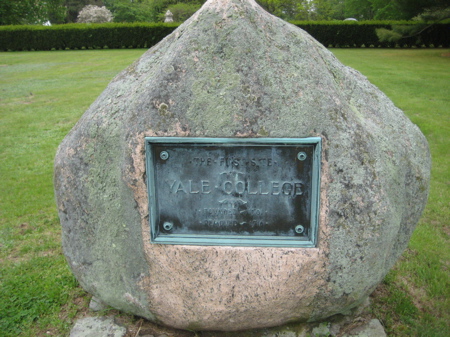
THE FIRST SITE OF YALE COLLEGE / FOUNDED 1701~ / REMOVED 1716~
Simple enough, right? Yale started here over 300 years ago and it ended up in New Haven peaceably and lots of smart and important people have attended through the years and that’s that. On to the next thing to write about…
Wait? That’s not the whole story? Nope, not at all. As it turns out, I DO have to don some ninja gear to wade through multiple contradictory histories of Yale. Writing this page became as difficult as founding a top institution of learning.
I posted the rock as one of the ongoing “Sunday Stumpers” on the CTMQ Facebook group, one of the response I got as to the rock’s whereabouts was:
The original classes for what is now called Yale University, were actually held at Rev. Pierce’s church on Main Street, in what is now known as Clinton, CT. (from branfordpatch.com)
This response was from a very smart person and seconded by an equally intelligent person. Hm. That was odd – and with a source (albeit a Patch site) as well. But my rock was in Old Saybrook. So where should we start? Let’s start at the beginning beginning, which may or may not be in Branford and/or Clinton and/or Killingworth…
On the Branford town green, there is a sign:
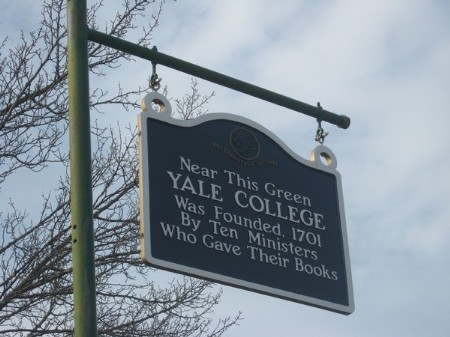
(Photo credit: Branford Patch)
The sign on the Green says: “Near this Green, Yale College was founded, 1701 by ten ministers who gave their books.” Hm. That’s shady. A commenter named Wayne Cooke on this Branford Patch article, who certainly seems to know what he’s talking about wrote (bolding mine):
“The formal, legal founding of Yale took place at a meeting of the General Court of the Colony of Connecticut from October 9-16, 1701 that approved an “Act of Liberty to erect a Collegiate School”.
However, tradition has it that, prior to the General Court meeting, ten Connecticut ministers gathered in the south Parlor of Rev. Samuel Russell’s parsonage in Branford and together presented forty books with the words that went something like “I give these books for the founding of a College in this Colony.”
The original idea to establish a Collegiate School came from New Haven founder Rev. John Davenport’s “long and insistent efforts” from 1647 to 1668.
After John Davenport’s death, the idea was revived by his successor Rev. James Pierpont some time between about 1685 and 1689. Pierpont is presumed to have first involved his friend and Harvard classmate Samuel Russell and then the recently ordained minister Samuel Andrew of Milford. Eventually the prime movers were Rev. Pierpont, Rev. Israel Chauncy of Stratford, and Rev. Abraham Pierson of Kennelworth. Others in the group included Reverends Thomas Buckingham of Saybrook, Samuel Mather of Windsor, James Noyes of Stoningham, Noadiah Russell of Middletown, Joseph Webb of Fairfield, and Timothy Woodbridge of Hartford.
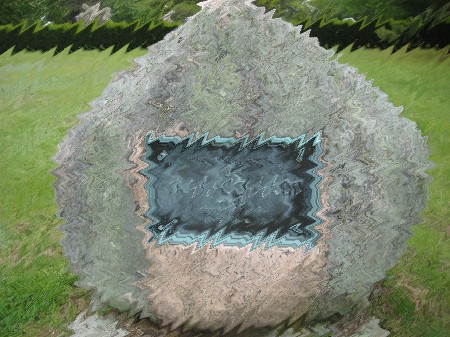
The boulder through a windshield in a monsoon
The first class of the new school–consisting of one student– was held in Killingworth the following year, Soon thereafter, the library was moved to Saybrook until finding its final home in New Haven.”
“Tradition has it,” he says. We all know what that means. Anyway, let’s turn to another commenter on that article named Eileen O’Connor, who explains where Clinton/Killingworth come into play:
“A slight correction to this history, is that Rev. Abraham Pierson, from what was then called Kennelworth, held the first class in the town center of Kennelworth. Due to “issues” between the two churches in the original town of Kennelworth, the town was divided into what is now known as Clinton and Killingworth. The original classes for what is now called Yale University, were actually held at Rev. Pierce’s church on Main Street, in what is now known as Clinton, CT. It was later moved to Saybrooke and then eventually into New Haven. It is unfortunate that this history of the division of Kennelworth is not known to the people at Yale and that they “assume” that Killingworth was all of Kennelworth.
Unfortunate indeed. Let’s buy all this for the time being. Basically, a bunch of ministers got together in Branford with all of 40 books between them and sat around a table and said, “Let’s start a college!” Then they got one guy to read a couple of the books in one of the guy’s churches that was in Kennelworth which became Killingworth but then that part of Kennel/Killingworth became what is now Clinton.
Does that count? Was that the beginning of Yale? Our rock in Old Saybrook says, “NO!” Here’s that rock again in case you were missing it:
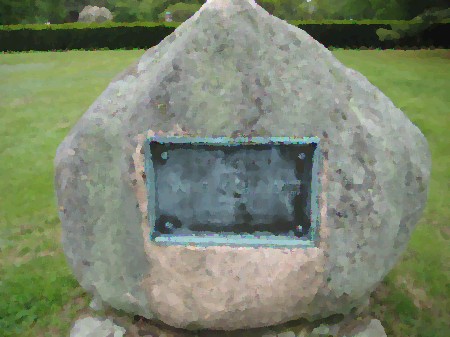
An oil painting of the boulder
The Branford Patch author, Alana Joli Abbott, followed up with another article about this controversial divide and added a ton more to the pre-Saybrook debate. Here are some selected snippets from her second article (bearing in mind she’s Branford-proud):
“In a 1999 book, Yale: A History, Brooks Mather Kelley tries to discount the “Branford meeting” as folk tradition. Kelley complains in a footnote that the legend persists, despite having the historical documentation to back it up.
The only evidence that there even was a Branford meeting is the fact that John Eliot addressed his reply to the ministers to Abraham Pierson “at Bramford.” The possibility that a pledge of books was made or discussed in Branford is revealed by James Noyes’s letter, 28 October 1701, to James Pierpont… informing Pierpont that he cannot attend the trustees meeting in Saybrook and continuing, “Probably my brother will be with you. I doe hereby desire and impower [SIC] him to give out my books at his house in my full proportion.”
For Kelley, these mentions just aren’t enough, especially given the possibility that Noyes’s inability to travel would have made it difficult for him to have made it to the Branford meeting to discuss books. Kelley posits that the discussion about books must have happened at some other time, most probably at the Assembly or at a different meeting in New Haven.
But then why has the tradition of Branford as the founding location persisted?”
I encourage you to read Abbott’s full piece, but I’m going to jump ahead to this sentence, “So, the spirit of the founding took place in Branford, and the official founding took place at the General Assembly.”
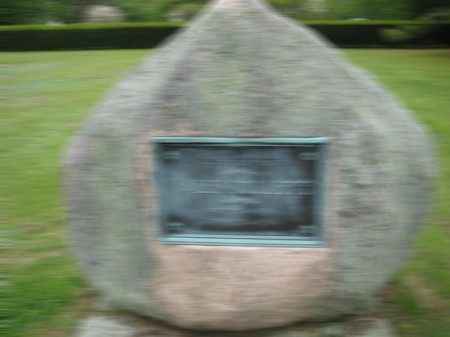
The boulder as you drive by it at 30 mph
Here, she refers back to Irene O’Connor’s comment about the whole Kennelworth thing which turns out to be historically accurate. Again, here are Abbott’s words:
”According to the Killingworth Historical Society, Not only was Pierson among those at the Branford meeting, he was also chosen by the trustees to be the first rector, or president, of the college. Saybrook was always intended to be the spot where the college would be built, but while the buildings were in progress, classes should start by being held at the rector’s home. Lucky Pierson! At Pierson’s death, not long into his term as rector, the new rector, Samuel Andrew, held classes for the seniors at his home in Milford. (The underclassmen began their course load in Saybrook.)”
Holy crap, now Milford is in play? (Oh just you wait, Hartford and Wethersfield play a role too… Well Hartford has already played a role with their General Assembly voting…)
All this actual stuff – the meetings and the “classes” and the books being bandied about – all happened in 1701 by the way. So okay, our rock in Old Saybrook – how about a close up shot now:
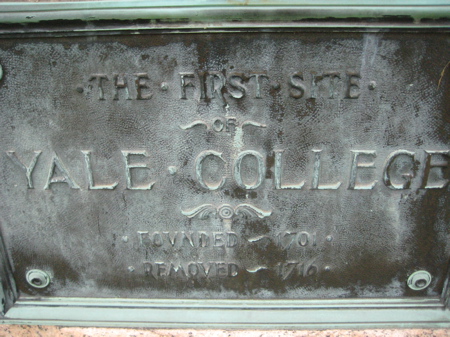
– Our fair rock apparently marks the site of the first building built with the purpose of being a college. It doesn’t mark where the mere idea for that college was dreamt up (New Haven) or where a vote upon it was taken (Hartford and Branford) or where some books were gathered in a church (Kennelworth or Clinton or Killingworth), but where an actual physical and tangible building was built for the purpose of educating rich white Christian males. It all sort of makes sense now, but let’s dig deeper.
Let’s turn to CT Heritage’s article about this mess by Bruce P. Stark, edited a bit by me.
In November 1701 the trustees of the Collegiate School met in
Saybrook Branford, gathered together some forty volumes from their own small libraries, drew up a course of study, designated the Reverend Abraham Pierson (1645-1707) of Killingworth as rector, and chose Saybrook as the site for the College. The first students studied in Killingworth, however, because Pierson’s congregation refused to release him from his pastoral duties. After his death the students removed toSaybrook Saybrook and Milford, but the trustees voted in October 1716 to move the struggling College to New Haven. New Haven was chosen over Wethersfield and Saybrook because it pledged the most money to support the Collegiate School and because a majority of the trustees present and voting were from the New Haven area. The choice was opposed by the Hartford trustees and a two-year struggle ensued with students split among tutors in Wethersfield, New Haven, and Saybrook before the majority with the strong support of Governor Gurdon Saltonstall (1666-1724) prevailed.
At least now we know where that terribly named terrible bridge’s (Saltonstall) name came from. I really only included that bit to show that even our historical resources may not be totally historically accurate. Let’s now look at another history, from Tedd Levy and >his article about this from same publication called the Shoreline Times. Interesting that this appeared in the “opinion” section!
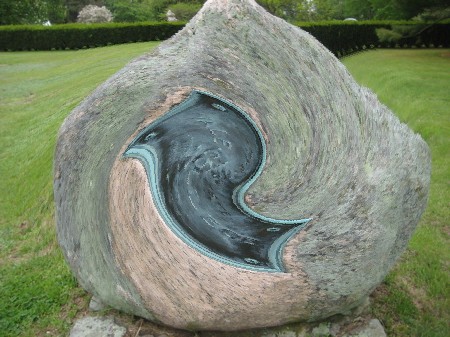
The boulder while tripping on LSD
Which is good, because Levy writes, “The fairly well known story has its roots in the growing population and need for ministers for Connecticut churches. Ten ministers met in Saybrook and organized as trustees to establish a college.” Tsk-tsk.
But the article does bring us up to the actual building in which Yale physically began:
“Rev. Thomas Buckingham of Saybrook emerged as an influential leader, with commencement ceremonies usually held in his home. Nathaniel Lynde of Saybrook generously gave a long, large one-story frame house and ten acres for the college as long as it remained in the town. This house stood near the cemetery, probably some 400 feet north of the Yale Boulder, and is presently occupied by the brick Samuel Willard House, which some believe was constructed on top of an old foundation in the mid-1800’s.
During this time disagreements continued over where the college should be located. Supporters in Hartford and Wethersfield vied with others who fervently favored its removal to New Haven. In addition, some students were unhappy with their instructors and upset at having to travel long distances to their instructors. Some received instruction from their own pastors. A small pox outbreak in Saybrook persuaded a number of students to attend classes in East Guilford.”
EAST GUILFORD NOW?! Jiminy Crickets. The Saybrook side of the story and how they “lost” Yale gets pretty cool. Let’s look at that close-up shot again and focus on the word “Removed.” Okay, also focus really hard on the added words between “THE FIRST SITE” AND “YALE COLLEGE”:
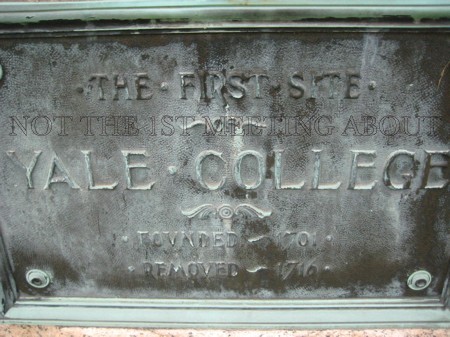
Can you read it? I used a special technique to uncover the original inscription.
“In 1718 Elihu Yale, an English merchant and philanthropist, governor of the East India Company, sent a carton of goods to the school which was sold for 800 pounds. The funds were used to constuct a building that was named after him and later the entire school was named in his honor.
Soon thereafter, the General Assembly gave the trustees the authority to remove the remaining books from Saybrook to the college in New Haven. Not surprisingly, there was opposition.
The books were stored at Rev. Buckingham’s house and when the sheriff came to collect them, he found a large assembly of men determined to resist. He forcibly entered the house, after a scuffle succeeded in taking the books and securing them under guard during the night.
On their way to New Haven, the scuffles continued and the still angry residents tore up the plank bridges. When the sheriff and his deputies finally reached New Haven they had about 1000 books and papers. In the disturbances, some 260 books were ‘lost’.”
Wow. And if you think about it, the Old Saybrookers had a point. Look at what Yale means to New Haven and really, the world now. That could have been Old Saybrook. Tempers cooled a bit by 1901 when a 200th anniversary celebration was held in Old Saybrook. That’s when the boulder was carted in and the plaque was placed.
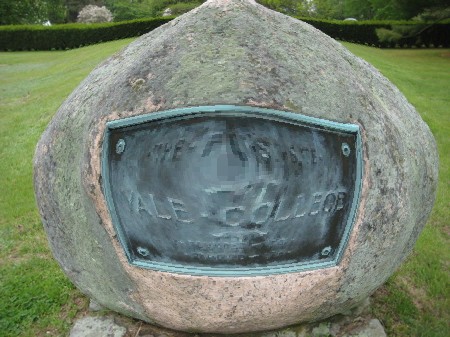
The boulder if you were a fish
But why is it in a cemetery? For that, we turn to the Cypress Cemetery’s website, which now brings in some more controversy about the felling of some trees as well as why Fenwick is called Fenwick:
“The Yale Boulder is a prominent marker that rests at the northwest corner of the Cypress Cemetery property along College Street. The plaque on the boulder states that the parcel of land is the former location of Yale College, which existed in Old Saybrook from 1701 through 1716. Actually, prior to moving to New Haven in 1717, the college was known as the Saybrook Collegiate School and its purpose was for the education of much needed new clergy in the Connecticut colony.
The plot was at one time surrounded by trees of significant size. In 1967, the newly appointed Municipal Cemetery Commission chairman Mrs. Ferdinand Ross caused the removal of the 68 surrounding trees and replaced them with 68 English Hawthorne at a cost of $12.95 each, plus $1 each for planting. Apparently, the tree removal occurred so quickly and unexpectedly that there was a public backlash with plenty of upset and criticism, “harrassment in the newspapers ” and some threatened law suits. Being a strong-willed woman, Mrs. Ross proclaimed that she would not “quit under fire”.
As for Yale, it is widely thought that the collegiate school did not actually exist at the location marked by the boulder, but was located several hundred feet west of that location at the corner of College Street and Willard Avenue. The site is presently occupied by a beautiful brick dwelling – the Samuel Willard House that was said to have been constructed on top of an old foundation in the mid-1800’s. That old foundation is thought to be that of the house originally belonging to George and Lady Fenwick and which was sold and eventually occupied by Nathaniel and Susanna Lynde. It was Nathaniel who deeded the original house for use by the collegiate school as long as it remained on Saybrook Point. He was also the collegiate school’s first treasurer, as noted on his burial tablet.
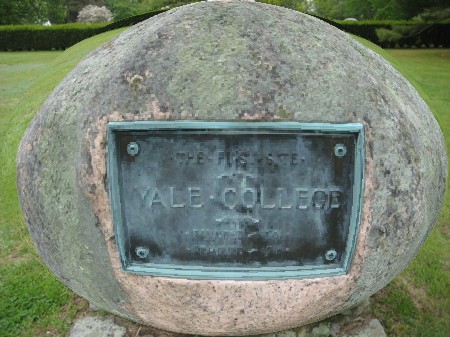
The boulder if you pumped it up with air
In that the plot is owned by Yale University, the upkeep of the hedge around the plot and the plot itself is carried out by Yale. In honor of its beginnings on Saybrook Point, one of Yale’s 12 residential colleges is known as the Saybrook College, which was founded in 1933 and named for the location of Yale’s origin.”
I just love how each thing I quote always has some sort of passive-aggressive bit about how Yale was founded in Branford or Old Saybrook. I love this stuff – especially since the school is no longer in either place. Although, the fact that Yale owns the plot of land (and hence, no gravestones as I mentioned way up above) is pretty cool.
2019 Update: I just read that Yale’s move from Saybrook to New Haven in 1716 was “not a popular decision with Saybrook and a cart of books leaving town was set afire by angry residents.” So there you go.
There is a last bit of history to clear up. Saybrook College (and Branford College for that matter) at Yale has its own history write up on Yale’s own website:
“Saybrook College, opened in 1933, shares the Memorial Quadrangle with Branford College. The Memorial Quadrangle, a gift of Mrs. Stephen V. Harkness in 1917, was then remodeled with funds provided by Mr. Edward S. Harkness, Class of 1897, to create a system of residential colleges, modeled after the Oxford and Cambridge college systems.”
Ah yes, the Harknesses. Yes, those Harknesses. The ones from Eolia at Harkness State Park. Getting back to Yale’s official history, which is what miffs Branfordites and Killingworthians…
“Saybrook College takes its name from the Connecticut town where the Collegiate School-which would later be known as Yale College-was founded in 1701, and where instruction would be offered from 1707-1716. The two college courtyards retain millstones that were driven to New Haven by oxen in 1921 from the towns of Saybrook and Killingworth. Numerous carvings, sculptures and armorial decorations adorn the arches and entryways. The blue and gold Saybrook College arms descend from the arms of William Fiennes, First Viscount Lord Saye and Sele (1582-1662), and Robert Greville, Second Baron Lord Brooke (1608-1643), co-founders of the original colony of Saybrook and noted English Puritans who never left Britain to visit the town they supported in New England. The badge of the College is the grapevine, derived from the original seal of Saybrook colony. The grapevine motif can be seen throughout the College, most notably carved in stone over the High Street gate and in needlepoint in the Saybrook Arras in the Dining Hall.”
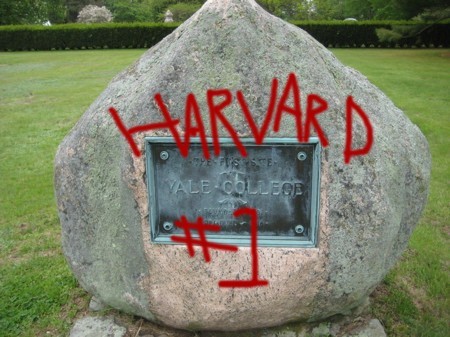
The sad case of the graffiti boulder
Wow. That’s some detail. But they left out one last connection to Saybrook: Today, at Yale, there is a statue of the first rector Rev. Abraham Pierson – the Killingworth guy! In 1932 Yale donated books to Old Saybrook’s Acton Public Library.
And finally, to put all the ugliness of the early 18th century behind them, in 1975 Old Saybrook’s First Selectman Barbara J. Maynard “apologized” for the town’s unruly behavior. And the same banner that is used by Yale is used by the Town of Old Saybrook as its municipal flag and seal.
Ta-da! More than you ever wanted to know about the founding of Yale. Depending, of course, on your definition of “founding.” I’ve settled on the Old Saybrook boulder being the correct monument to the founding of Yale.
Sources:
All long gone except the Branford Patch articles, linked above.
![]()

 dstb says
dstb says
December 22, 2011 at 4:45 pmHi Steve,
I’ve always wondered about that boulder, though obviously not enough to do the research myself. We go by it every summer on our way to visit relatives in Old Saybrook and Fenwick.
The “graffiti” seems appropriate, not only because Harvard was the first college in the US, but also because most of the originators of Yale seem to have been Harvard men (based upon my exhaustive research on Wikipedia).
Thanks for the history lesson.
Sarah
 Linda Wightman says
Linda Wightman says
December 23, 2011 at 9:19 amGreat article, thanks! (Do not be misled by the fact that so many spam comments begin the same way.) My husband grew up spending summers in Old Saybrook and remembers the tree controversy.
A little digging led me to realize that the Rev. Thomas Buckingham is my 8th great-grandfather. Perhaps I should pay a visit to Yale and ask for my books back. Or at least a full-ride scholarship.
 Alana Joli Abbott says
Alana Joli Abbott says
September 25, 2013 at 1:22 pmWow, sorry for the belated comment, but I just now found your article which links back to mine. Thank you so much! And thanks for filling even more details in about this wacky debate.